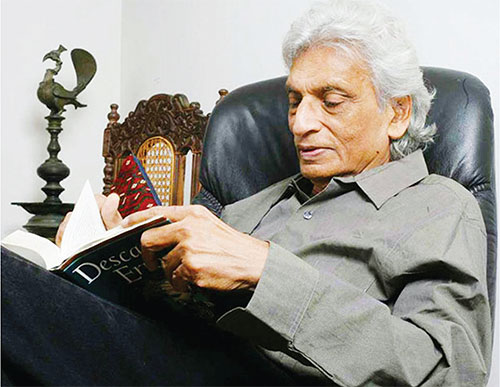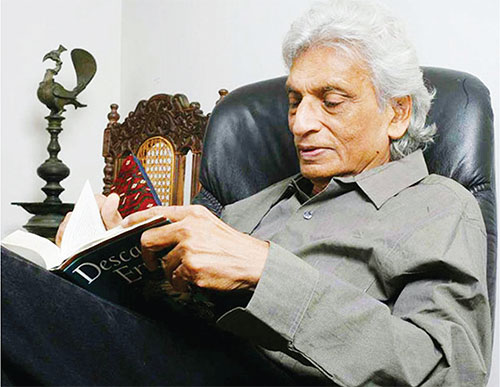By P.K.Balachandran /Daily Mirror
Colombo, September 12: The Veddas, the original inhabitants of Sri Lanka, were once numerous and lived throughout the island. But they have almost disappeared now, being less than 0.13% of the population according to the last census taken in 2011. Presently, they are confined to the Bintanna area in South Sri Lanka and Batticaloa district in the east.
These days, the Veddas are treated as museum pieces to be shown to Western tourists fascinated by antiquities. And the Veddas themselves appear to be encouraging this, willingly posing for pictures, bare-bodied, hair unkempt, and carrying an axe or a bow and arrow.
But this is a caricature of the community, whose past is as noteworthy as those of the dominant communities of Sri Lanka.
If the Veddas were numerous and widespread in the past, where did they go eventually? Were they exterminated as native Americans were after the Whites arrived in North and South America
No, they were not, says Gananath Obeyesekere, Emeritus Professor of Anthropology at Princeton University, in his work: Colonial Histories and Vedda Primitivism: An Unorthodox Reading of Kandy Period Texts.
His study of the Veddas from the 1960s onwards showed that they were neither annihilated nor erased, but were absorbed by the dominant Sinhalese and Tamil communities through a symbiotic process based on a cultural give and take, inter-marriages and sexual unions.
He decries the popular notion that the Veddas were always hunter-gatherers, and were never into agriculture, which set them apart from the Sinhalese and the Tamils who practiced settled agriculture.
Obeyesekere’s studies revealed that the Sinhalese, Tamils and the Veddas were alternately or simultaneously, hunters and agriculturists. All three communities eventually took to settled agriculture which became their common preferred occupation.
In the past, Kandy district, which is the epicentre of Sinhalese Buddhist culture now, was populated by the Veddas. So was Vellassa in Monaragala district. The latter was known traditionally as Vedi Rata (Vedda land). While most residents of Vedi Rata now claim that they are Sinhalese, some in interior Vedi Rata, admit that they were Veddas originally.
The people of this area have a plethora of myths about their origin in the Vijaya-Kuveni marriage and their subsequent flight to forested areas. The story is that Prince Vijaya, a Kshatriya from Bengal, had come to Sri Lanka in 543 BC to settle. He married Kuveni, a local Vedda, but only to abandon her in favour of a Kshatriya Princess of Madurai in South India.
It is believed that Vijaya’s abandoning Kuveni led to a fight between his men and Kuveni’s people- the Veddas. The unequal battle led to the flight of the Veddas to the jungles of Central and South Sri Lanka.
Thereafter, the dominant community in Sri Lanka, the Sinhalese, believed to have been created by the union of Vijaya and the Madurai Princes, paid no attention to the Veddas. The Veddas disappear from Sinhalese records.
Obeyesekere notes that Pali language chronicles like the Mahawamsa ( Fifth Century AD) written by orthodox Sinhalese Buddhist monks, are silent on the fate of Kuveni’s people.
Intermediate Texts
However, non-Pali texts written in Sinhalese language by laymen, have plenty of references to the Veddas. Obeyesekere calls these “intermediate texts”. These are the Vamsa katha, Vadi Vamsaya and Vanni Rajavaliya. Then there are the Vitti Pot, or “stories about episodes or events;” and finally, the Lekam Miti or land-tenure registers.
Obeyesekere points to a ritual known as Veddan andagahima, or “roll-call of the Veddas,” sung during the Kohomba kankariya ritual which suggests that the Vedda territory was practically coterminous with the present-day Kandy district. Over ninety Vedda villages fell in this area.
Obeyesekere buttresses his case by pointing out that the kingdom of Vikramabahu III (1357–1374 AD) – namely Kandy – was established in a village then called Katupulla that was ruled by a Vedda chief known as Katupulle Vedda. The Kandyan kings had a police force known as Katupulle Atto, a Vedda term.
Matale, in Kandy district which is now a stronghold of the Sinhalese Buddhists, was also a Vedda area. The leading families of Matale at the time of King Rajasinha II’s rule (1629-1687), were Kulatunga Mudiyanse of Udupihilla, Vanigasekere Mudiyanse of Aluvihara, Candrasekere Mudiyanse of Dumbukola (Dambullal), Gamage Vedda and Hampat Vedda of Hulangamuva, who were all Veddas with honorific Sinhalese names.
The lands beyond Matale were under the guardianship of Kannila Vedda, Herat Banda, Maha Tampala Vedda, Valli Vedda (perhaps a female), and Mahakavudalla Vedda, to name only a few.
Obeyesekere submits that the Vedda chiefs and the Sinhalese upper class intermarried. For example, a Vedda King of Opaigala married the daughter of a Sinhala king, Vira Parakrama Bahu. His son was named Herat Bandara, in Sinhala style.
Veddas as Agriculturists
The term Vedda comes from the word Vyaadha (to pierce), that is to “hunt”. However, it is wrong to think that hunting was the Veddas’ sole occupation, Obeyesekere says.
The Veddas were also agriculturalists. Names like Herat Bandara indicate that they would also have practised agriculture in addition to hunting. Obeyesekere points out that the Sinhalese farmers of the top Govigama caste also practised hunting in addition to agriculture. “Game” which is the flesh of hunted animals, is relished by the Sinhalese Buddhists to this day.
According to Vaadi vamsaya, the Veddas rendered various services to the Sinhalese kings. They served in their armies, hunted for them and safeguarded demarcated sections of these territories. For these, they were rewarded with titles, honours and the guardianship of territories.
For example, Panikki Vedda, an elephant catcher for King Bhuveneka Bahu of Sitavaka (1521 to 1551) was given the over-lordship of the four districts or Pattus, namely, Puttalam Pattu, Munessaram Pattu, Demala Pattu, and the Wanni Hat Pattu, and honoured with the title “Bandara Mudiyanse.”
It can be assumed that the descendants of these distinguished Veddas became “Bandara Veddas” or Veddas with high rank, and then merged with the Sinhala Bandara aristocracy, Obeyesekere says. Panikki Vedda was deified at his death. He is still propitiated in rituals over a vast area of Bintanna- Vellassa.
The clan of the Vedda girl Kuveni, whom Prince Vijaya married initially, was a group of hunters or “Sabaras”. They were forced to migrate to what is now the Sabaragamuwa province after the Vijaya-Kuveni marriage broke.
No wonder, in Sabaragamuwa province, there are place names like Veddi Pangu (“Vedda’s land share”), Veddi Kumbura (“Vedda rice fields”), Vedivatta (“Vadda gardens”) and Veddagala (“Vedda rock”). These are now Sinhalese villages.
When the Sinhalese of Uva province staged an armed revolt against the British in 1817-1818, the local Veddas sided with them. A Vedda chief, Kivulegedera Mohottala, along with many other leaders of the revolt, was captured and executed. To this day, Kivulegedera Mohottala is deified in this area as Kivulegedera Punci Alut Deviyo (the younger new god of Kivulegedera). He had been transformed into a fully Sinhalized hero of the Sri Lankan resistance to the British.
END
The post What happened to the Veddas, the indigenous people of Sri Lanka appeared first on NewsIn.Asia.




